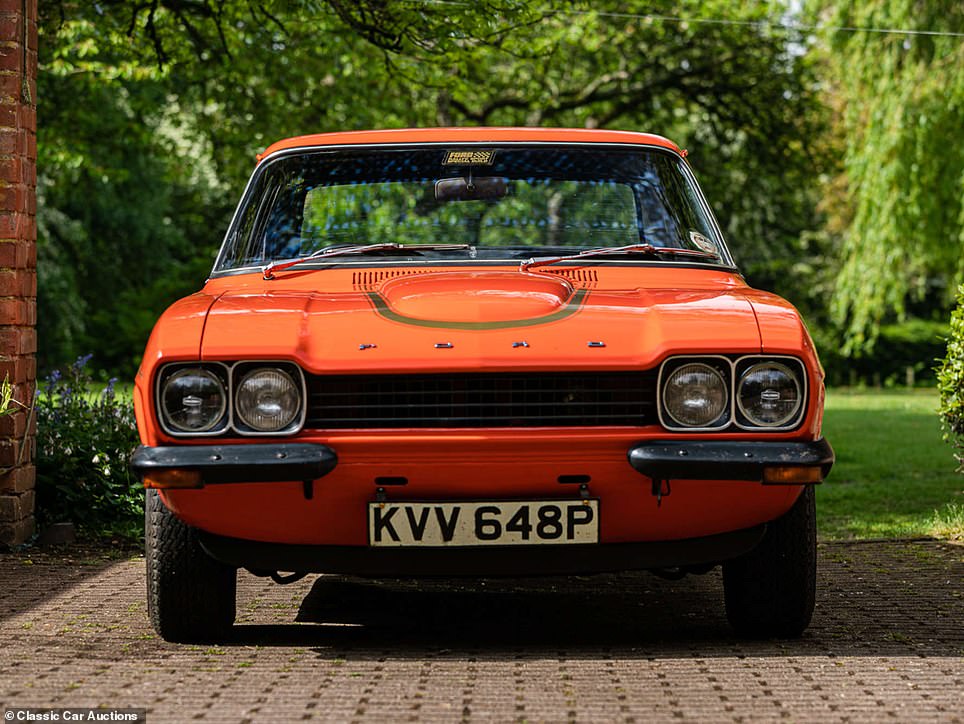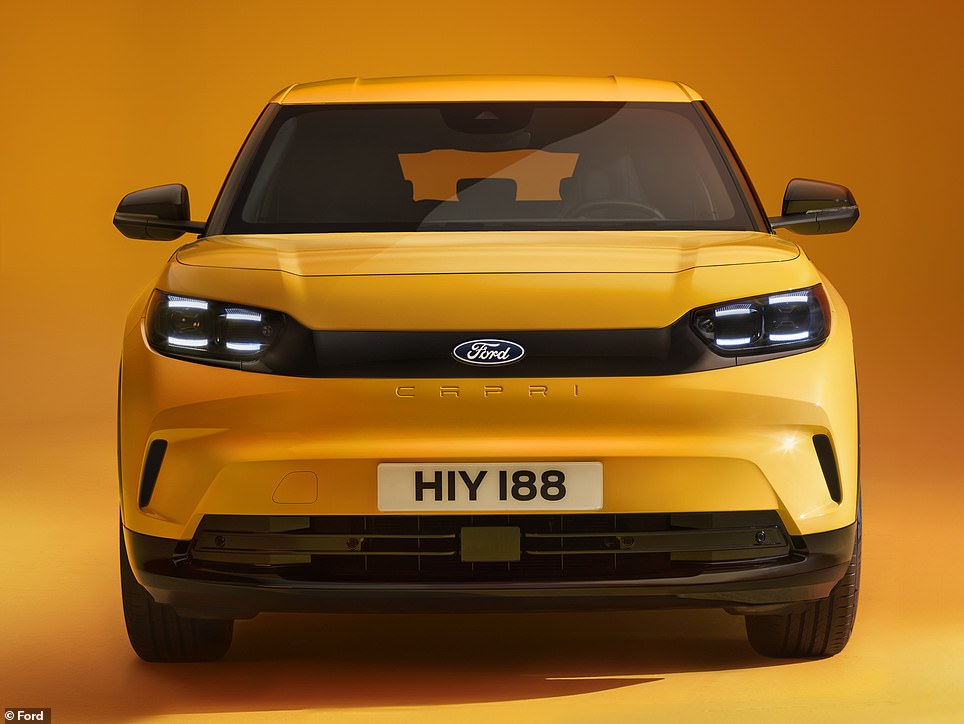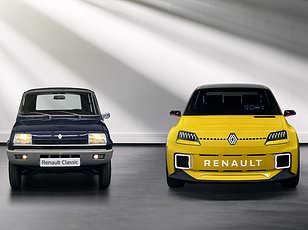- Ford Capri EV might be the most talked about new car of the decade - but will people ever get over the name?
It was hard to miss the relaunch of the Ford Capri earlier this year.
Former Manchester United footballer Eric Cantona was the face of the campaign, with his now infamous tag line 'the legend is back' part of a media blitz of bogus ads, viral social media clips of the Frenchman strolling down the high street with a goat, and confusing product placement at Glastonbury Festival.
But this failed to deflect from Ford's questionable decision to use one of its most iconic legacy nameplates for a new electric SUV which triggered a tsunami of widespread uproar.
'It has the soul of the classic Capri, reinvented with a new, modern design,' bosses at the blue oval brand declared. But it's fair to say the public response has been anything but welcoming, with Capri fanatics singeing their fingertips on keyboards as they furiously blasted the move on social media.
Yet despite all the critics [and there’s a lot of them], there’s no stopping the new battery-powered Capri from arriving in UK showrooms in a matter of weeks. And before it does, we test drove it in Marseille to see what it's like beyond the controversial name badge.

The new Ford Capri has been one of the most controversial releases in modern day motoring - but how does it drive? We reviewed it on launch to find out

Eric Cantona pictured with the 2024 Ford Capri having featured in a well-orchestrated viral social media campaign hinting at the return of one of the great automotive names of the seventies and eighties. 'The legend is back' is the tagline for the Capri campaign
Addressing the elephant in the room – the Capri name
'I'm sorry but that is not a Capri!'
This was one of the comments I received on Instagram when posting a few snaps of the car at the global first drive in the South of France earlier this month.
It’s no less than I expected.
Since Ford unveiled the reborn Capri to the public this summer, social media and mainstream press has been awash with similar sentiments.
In fact, there’s not a car unveiled in the last decade that I can recall garnering such overwhelmingly negative reaction.
So, there's no option other than to bravely address the elephant in the room – the fact that many Ford fans – and petrolheads generally - aren't happy about the name.
Even Ford's director of marketing, Peter Zillig, said he'd seen someone write that the brand's 'really stress-testing the notion of all publicity is good publicity' with the new Capri.
This isn’t comparing apples with apples; if the original Capri is a Granny Smith, the new one is a genetically modified kumquat.
The 2024 Capri isn't the burbling, petrol-gulping, low-slung, affordable, two-door sport coupe for boy racers of the past. Instead, it's a silent, battery-powered, high-riding, expensive, five-door juggernaut aimed predominantly at eco-conscious families.
Ford has - in its defence – made something of an attempt to pay homage to the original, including the oval LED inclusion in the headlights, the C-shape rear pillar, and the black blade panel stretching across the back like the Capri RS variants of old.
But it’s a limp effort and one that’s clearly been in vain in the eyes of the motoring fraternity.
A Capri by name but not scale: Ford says the battery powered 2024 Capri SUV 'continues the story of the iconic cult classic' and 'will inject some soul into the world of EVs'. But the public haven't been taking it all that well...
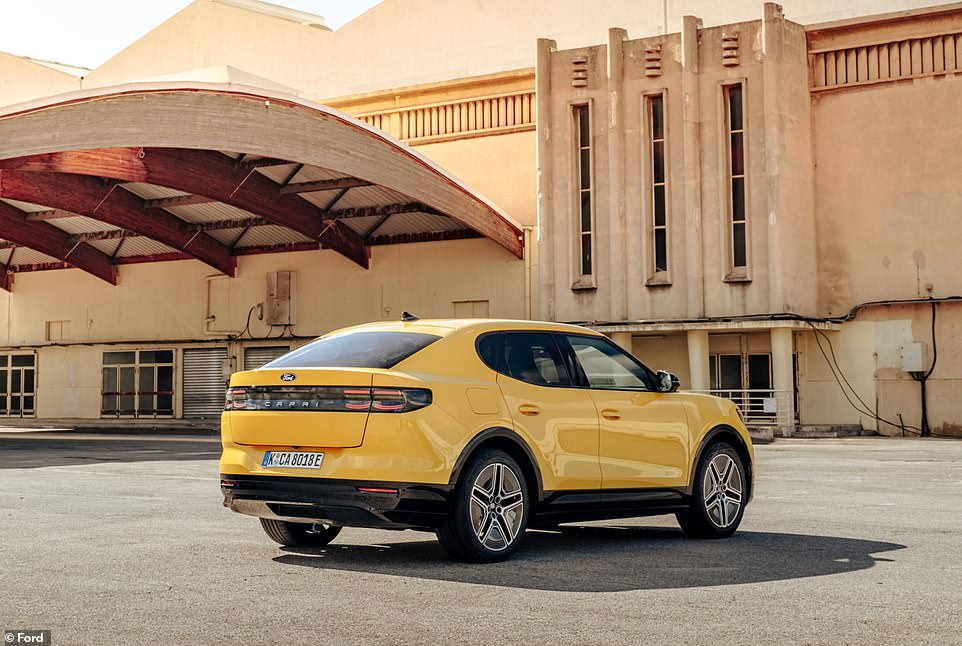
Many people aren't yet convinced about the new Capri: 'Using the Capri nameplate for this is blasphemy and disrespectful to the original Capri’ on person posted. Another user commented: 'Imagine previously making good cars for years, the cars of the everyday person, then getting rid of great vehicle lines for soulless and costly electrification and now producing this and calling it a Capri somehow? A fall from grace'
'Using the Capri nameplate for this is blasphemy and disrespectful to the original Capri,' one social media user vented on an official Ford social media channel.
Another user commented: 'Imagine previously making good cars for years, the cars of the everyday person, then getting rid of great vehicle lines for soulless and costly electrification and now producing this and calling it a Capri somehow? A fall from grace.'
For balance, I have scrolled [for some time] to attempt to find positive comments. The best I could dig up was a someone posting: 'I kind of like it.' Hardly billboard-worthy stuff, is it?

When it was first shown to the public in January 1969 at the Brussels Motor Show, it was marketed as a cheap, fast and fun coupe. Production for the car began two months earlier at the Halewood plant in Liverpool to ensure every UK dealer would have at least one Capri on its forecourt by the time sales started, such was the stir of demand it created
Why do people feel so passionately about Capri? A very brief history lesson
The history of the Capri is a long essay and one many Britons of a certain vintage will know oh so well, so here's a very brief recap...
The original was pitched as the UK’s answer to Ford’s roaring success with Mustang in the US around the same time. It looked brilliant, offered fantastic value, and came with some genius marketing.
And there was a Capri for most tastes – from sensible 1.3-litre engines all the way up to sexier limited-numbered RS3100 performance options.
Naturally, the two-door coupe instantly became a hit in the early seventies; Ford famously sold 400,000 of them in the first 24 months alone.
And that was largely because prices started from £890 in 1969, which equates to around £12,500 today – a third of what the cheapest new EV version will cost.

The Ford Capri was launched in 1969. It survived through three generations of the sporty coupe. Here is an advert for the original

The one millionth Ford Capri - an RS2600 - pictured coming off the production line at the Saarlouis factory in Germany in 1973
If you really want to flip a negative into a positive then you can say that Ford’s heritage is essentially sacrosanct at the point, as reaction to the Capri has shown.
With so many new brands entering the EV space, Ford has a legacy many brands would kill to gain in the next 100 years.
And that’s value if you can utilise it in the right way.
The problem is it can be as much a disadvantage as an advantage in terms of PR... as Ford is currently finding out.
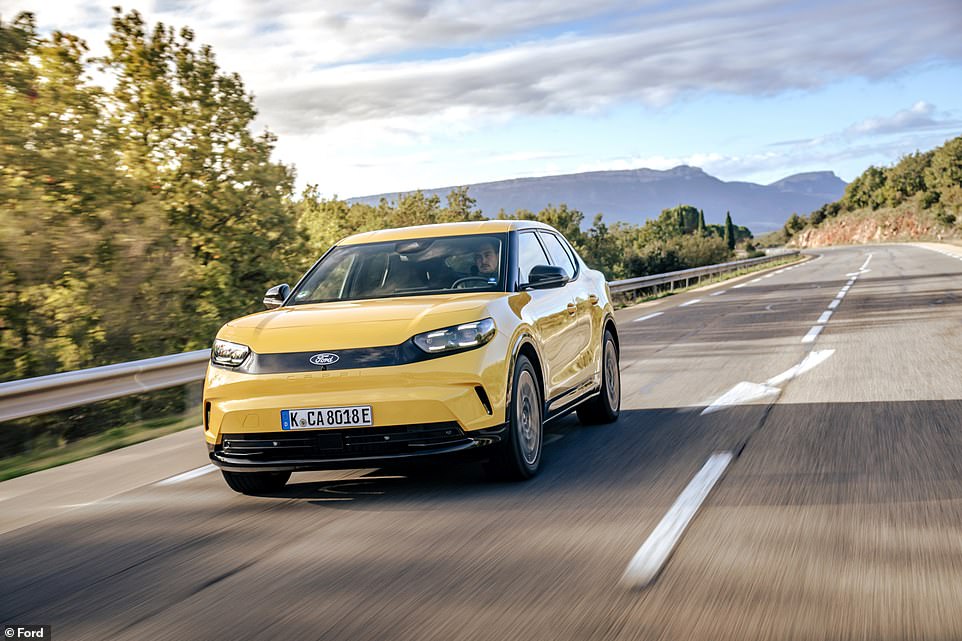
The rear-wheel drive has a longer range than the all-wheel drive: 389 miles versus 367 miles. The rear-wheel drive though is slightly slower off the mark managing 0 to 62mph in 6.4 second compared to the AWD’s 5.3 seconds
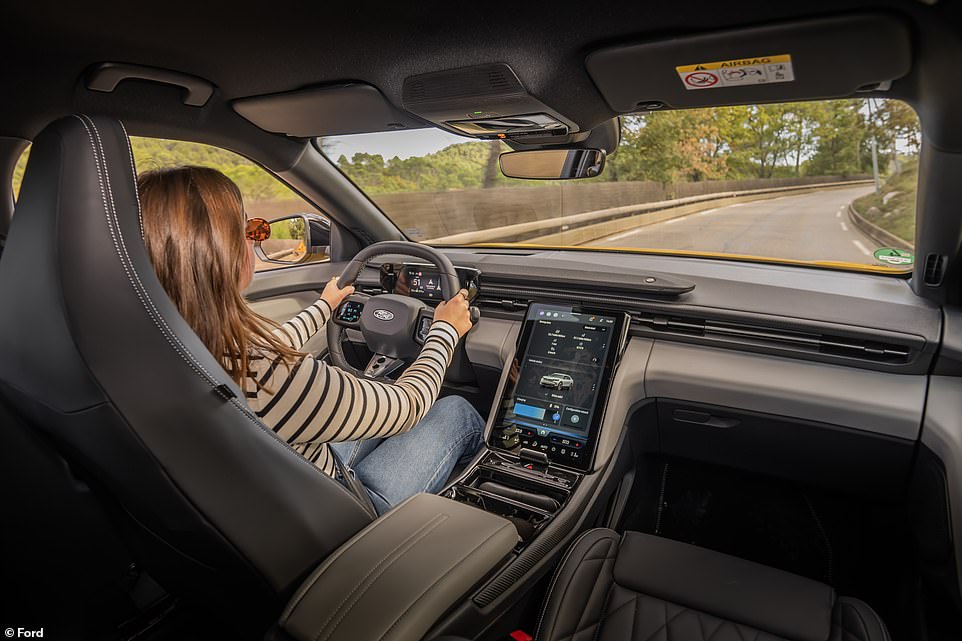
The Capri's shape and size (maybe this is just the case for someone of my size) lends itself to better visibility though; the Explorer’s visibility wasn’t good, and you couldn’t easily tell placement of the front wheels especially on roundabouts
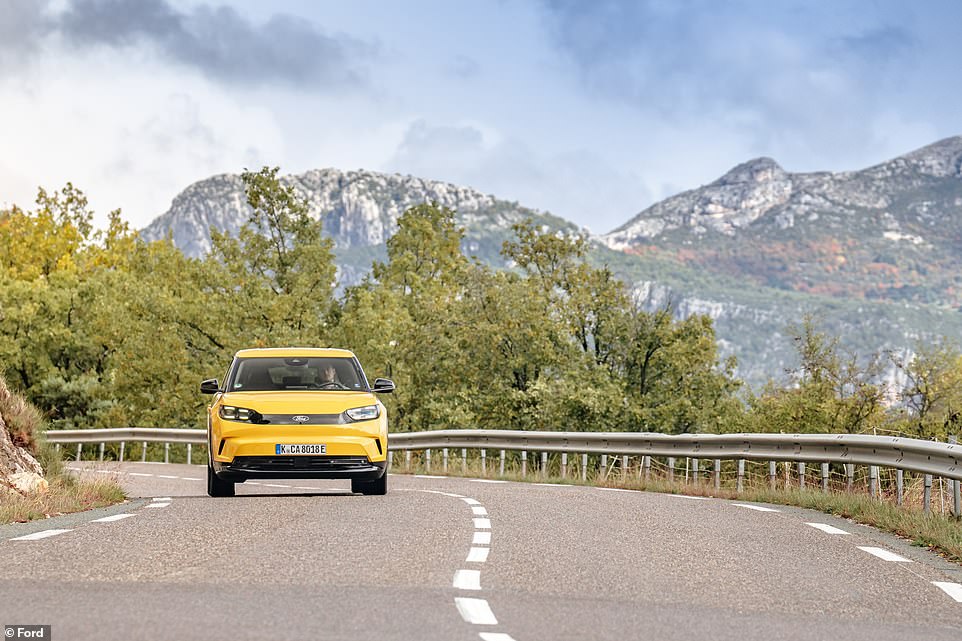
Another big win is that Capri is also much quieter than the Explorer, picking up less road and wind noise, which provides a more cossetting and relaxing driving experience
Nameplate aside – what is the Capri like to drive?
To start, it's best to judge Ford's newest EV as a car with an indeterminate nameplate. So that's what I'm going to do.
It's built on the Volkswagen MEB platform, just like its bigger sibling, the Explorer.
This is part of deal with the German car giant to help save costs, with VW giving access to its electric passenger car platforms in return for using Ford’s commercial vehicle developments – a 'you scratch my back, I’ll scratch yours' agreement of sorts.
Essentially, it means there's a VW ID.5 underneath the Capri’s bright yellow bodywork.
They probably should have called it the Ford Beetle.
Ford says it is 20mm lower to the ground than the bulkier Explorer and, by also fiddling with the suspension tuning, the technical department has made it feel far more accomplished in the corners.
The mild tweaks are a major boost to both agility and nimbleness compared to the boxier Explorer, and being hunkered closer to the tarmac has resulted in less body roll in corners, too.
Geert Van Noyen, vehicle dynamics manager for Ford of Europe, confirmed that the balance of the Capri has also been shifted towards the rear to give a sportier sensation. And that’s worked, too, with a greater feeling of the car being pitched on its nose and ready to nuzzle into the next apex.
The new Capri uses the Volkswagen MEB platform - one that underpins the VW ID.5 (pictured right) - which it shares with the new Explorer
Its shape and size (maybe this is just the case for someone of my limited height) also lends itself to better visibility; the Explorer's all-round view isn't good, and you couldn't easily tell placement of the front wheels especially on roundabouts.
Another big win is that Capri is also much quieter than Ford’s other EV SUV exploit, picking up less road and wind noise, which provides a more cossetting and relaxing driving experience.
I was delighted that despite having a suite of safety assists – there are 12 ultrasonic sensors, five cameras and three radar sensors – I wasn't nagged at all by the systems. This was a welcome change to the constant pinging most new cars give you.
During my stint in Marseille, I took both the 79kWh 335bhp all-wheel drive version and the 77kW 282bhp rear-wheel drive options for a spin. For reference, the RWD has a longer range than the AWD (389 miles versus 367 miles) though is slightly slower off the mark, managing a 0-to-62mph sprint in 6.4 second compared to 5.3 seconds.
Overall, if you’re dead set on a Ford and want to choose between the Capri versus the Explorer, the ride height and composure of the former wins out every time.
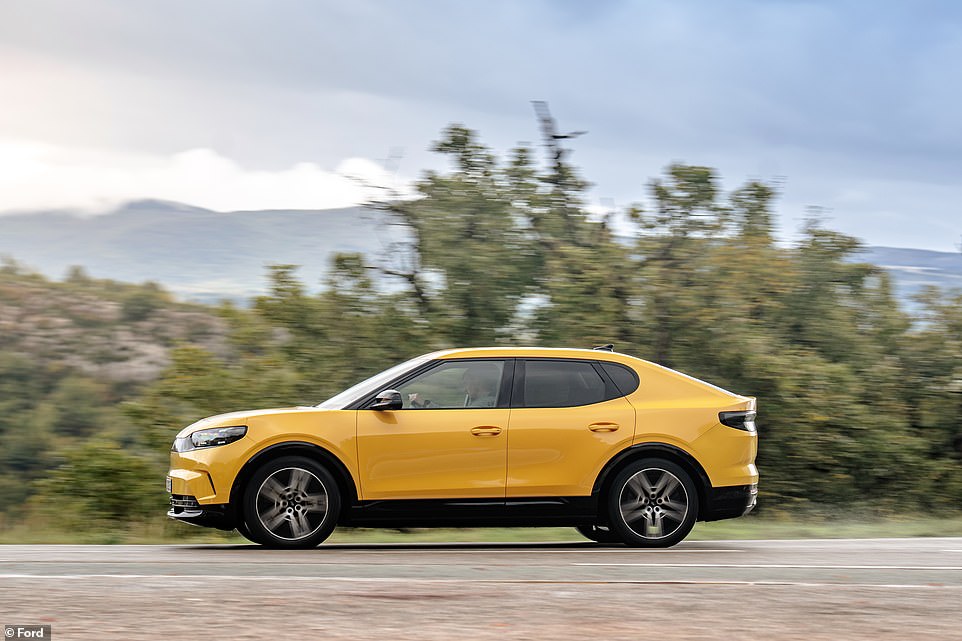
Fords says it's an ‘urban electric sports car’ that’s good for the whole family, and in that light, it drives well, has excellent range and is a very comfortable coupe-SUV for a wide range of people
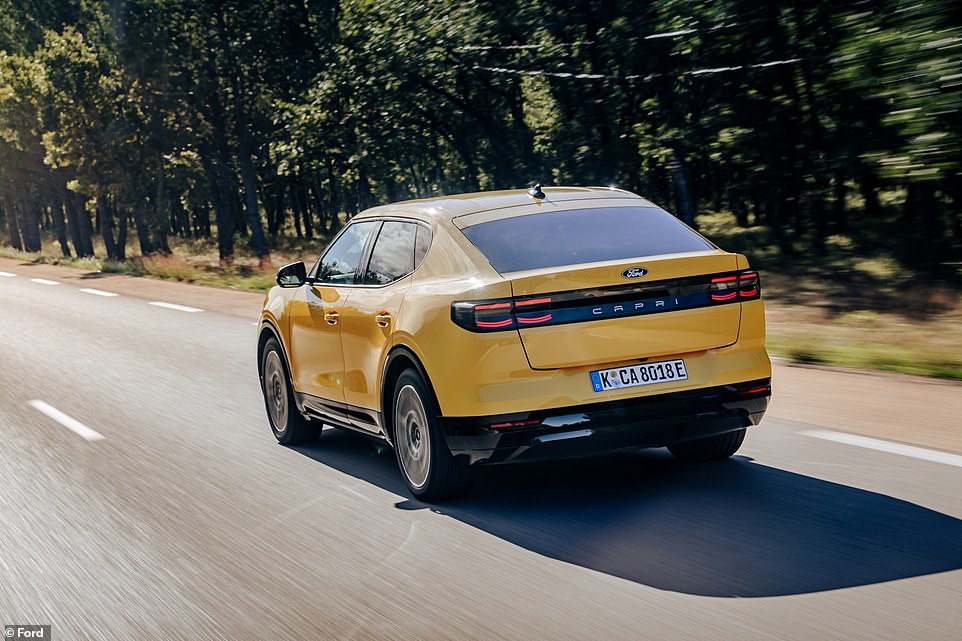
Unfortunately, the new one simply feels too samey. Close your eyes and you'll struggle to tell it apart from most EVs already on the market today
But how does it compare to EVs of a similar ilk from other brands?
Fords says it's an ‘urban electric sports car’ that’s good for the whole family, and in that light, it drives very well, has excellent range and is a very comfortable coupe-SUV for a wide range of people.
It also starts from around £10K less than a Polestar 4 (also a coupe-SUV) and has slightly quicker acceleration than its Swedish rival - though the Ford is nowhere near as luxurious inside and doesn’t have the same quality product feel.
But the big question every sceptic will ask is: does it drive like a Capri?
That’s when the world, which for the most part is marmite towards EVs, screams 'no!'
That's despite most Capris of old not always being golden to drive. You can't overlook the fact that they had Cortina ‘Kent’ engines. And press cuttings from the day dubbed the MK2 a 'sheep in a wolf’s clothing'.
But Capris always had personality.
Unfortunately, the new one simply feels too samey. Too nondescript. Close your eyes [not recommended while driving, of course] and you'll struggle to tell it apart from many EVs already on the market today.
No matter what Ford tells you and I, the Capri EV fail to deliver the flare and likeability of its predecessors – and that will be a very big problem for many.
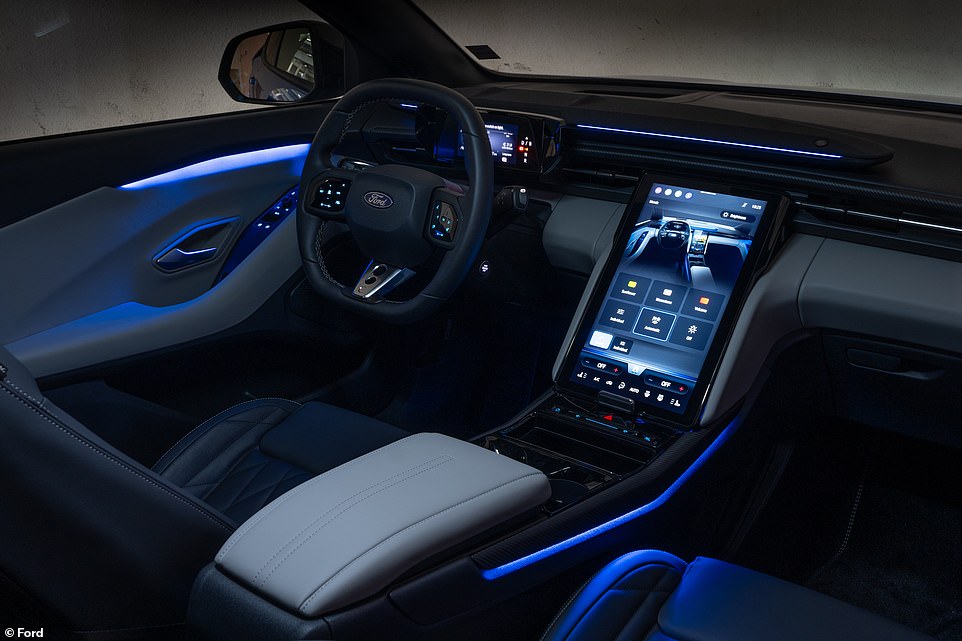
The Capri's interior is very comfortable, spacious and well-designed but it is a almost carbon copy of the recently-launched Explorer interior
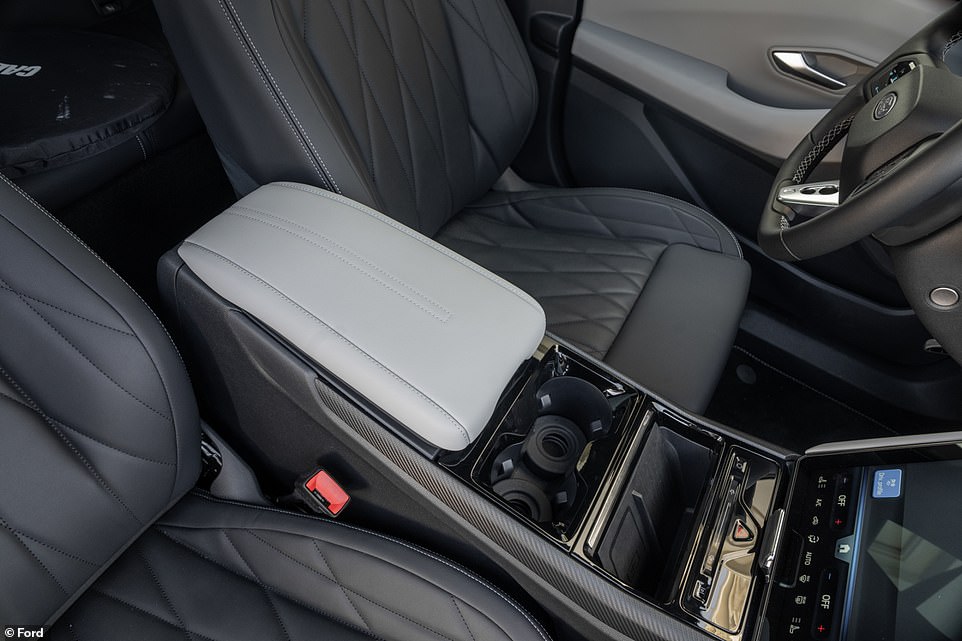
The mega console from the Explorer and the locker behind the infotainment screen (the screen moves and there's a hidden compartment behind) - are both carried across. Both clever features and perfect for family fun, but these features were sold as perfect for the Explorer because they had adventure in mind
Interior – is it a nice place to spend time and is it practical?
The interior is pretty much a cut and paste of the Explorer’s cabin: aside from one or two small individual details, including a single steering wheel spoke at six o’clock.
Is that a bad thing?
For comfort and practicality perspective, no. The Capri is a very pleasant car to be in and there’s a lot of practical storage.
The mega console (an incredibly deep centre storage unit under the arm rest) and locker behind the infotainment screen (the screen moves and there's a hidden compartment behind) are both welcome additions but, given they already feature in Explorer, don't feel all that special or unique.
The 14.6-inch infotainment screen is also the same as we've seen previously, which is a pity as it isn’t very intuitive and is fiddly to operate. We recommend syncing your Apple CarPlay or Android Auto from your smartphone, which is marvellously easy to do in the Capri.
Ford has also nailed boot space, offering 572 litres with a second floor and a side storage compartment.
It's class-leading (the Polestar 4 only has 526 litres) and is much bigger than the Explorer’s 450-litre capacity.
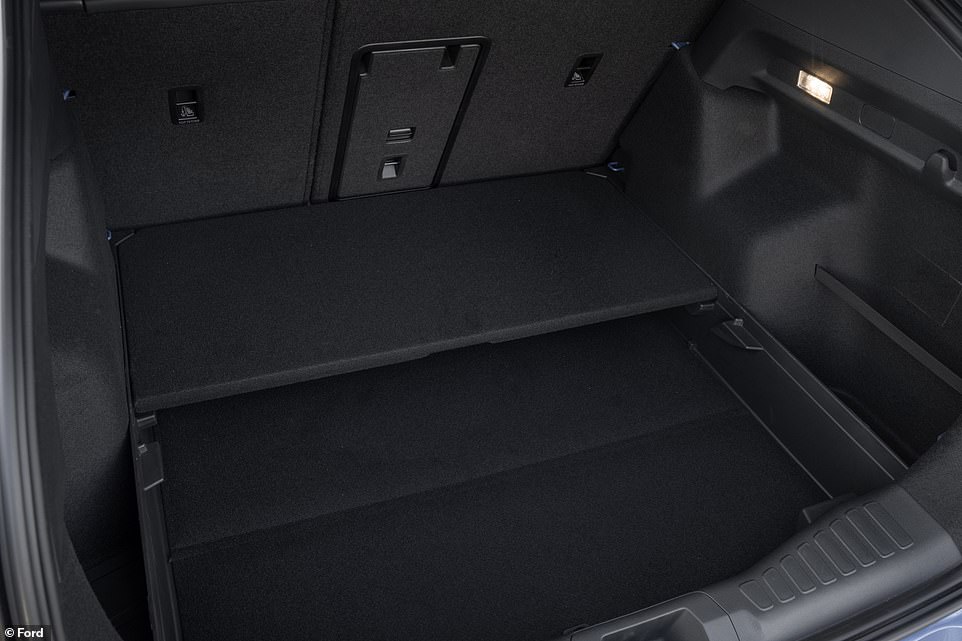
The boot is the standout of the Capri's interior and practicality with a massive 572-lites and a second floor to play with
Headroom and legroom are both good too - a 5'10 Ford employer had headroom to spare in the back for several hours on the road.
But you can’t shy away from Ford’s lack of effort in paying tribute to one of its legacy icons.
A car with the star power of the Capri name really deserves a bespoke interior to match, but it doesn’t get one.

The new Capri EV offers between 346 miles and 389 miles on a single charge, depending on the option you go for. Fast charging taps out at 100kW, which gives you 10 to 80 per cent charge in 26 to 28 minutes
Range and charging times and extras worth buying
The new Capri EV offers between 346 miles and 389 miles on a single charge, depending on the option you go for.
Fast charging taps out at 100kW, which gives you 10 to 80 per cent charge in 26 to 28 minutes.
Ford said that to keep costs down for all buyers, a heat pump is not a standard feature, instead you can opt to add one for an extra £1,050.
A heat pump - which uses heat from the battery to warm the cabin - saves you roughly about 10 per cent range so it is a useful feature to add if you're going to add anything.
There's also an retractable tow bar option for £750, which allows the Capri to tow up to 1,000kg, which is probably worth getting if you want to maximise your active lifestyle.
Pricing and trims
There are just two Capri trims: Select and Premium.
Both specifications are generously kitted-out, with Ford giving even the base trim all the same safety assists and cameras, as well as comfort features like heated seats.
The Premium additions include matrix headlights, a hands-free tailgate, ambient lighting, a panoramic roof, and a 10-speaker B&O sound system.
The Select RWD option will be the cheapest starting at £42,075 with the Premium AWD 79kW going up to £56,175.
For comparison, the Polestar 2 (which many people say the Capri looks like) costs between £42,950 and £55,950, the VW ID.5 (with the same platform) is priced between £45,860 to £55,720 and the Volvo EX30 from £31,995 to £42,495.
Order books are open with deliveries commencing later this year.
Ford Capri EV: The Cars and Motoring Verdict
Ford’s attempt to persuade people that an EV is deserving of a moniker bestowed to one of the most loved British cars of all time is at best ambitious marketing - and at worst a complete lack of judgement.
And it's not as if the company doesn't have a wealth of legacy nameplates that would have caused far less offence. An Escort for the EV era? A battery-powered Scorpio? People might just about have accepted that.
Yet the biggest falling isn’t the decision to recycle the Capri name but the lack of effort made to pay tribute to its predecessor.
Let's remember this isn't the first time a British four-wheeled staple has been reimagined: when BMW acquired Mini in 1996 and took on the legacy of Sir Alec Issigonis’ masterful design, arms were thrown skyward.
But while there are plenty who still say 'it's not a real Mini', the 'new' Mini has been a resounding success worldwide. And that's largely due to the attention of BMW to not only create cars that, to quote John Cooper, ‘put a smile on your face’ when driving but brilliantly reinterpreted classic Mini design features and brought them into the 21st Century.
With the Capri, Ford should have followed BMW’s footsteps and gone full in.
While there's no question this is a good electric car - as it should be for £42,000 - there's no steering away from the fact that it's trying to ride off the coat tails of a former legend rather than paying homage to it.
CARS & MOTORING: ON TEST
-
 Hyundai Inster review: Is it the affordable EV we've been waiting for?
Hyundai Inster review: Is it the affordable EV we've been waiting for? -
 The most controversial new car of 2024: We drive the Ford Capri EV
The most controversial new car of 2024: We drive the Ford Capri EV -
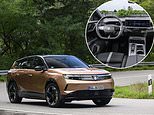 Has Vauxhall's grand plans for its new Grandland SUV paid dividends?
Has Vauxhall's grand plans for its new Grandland SUV paid dividends? -
 Aston Martin Vanquish: Britain's new brute of a sports car tested
Aston Martin Vanquish: Britain's new brute of a sports car tested -
 Renault 5 EV: Can it recreate the character and charm of the original?
Renault 5 EV: Can it recreate the character and charm of the original? -
 Polestar 4 EV: The first car sold in Britain WITHOUT a rear window
Polestar 4 EV: The first car sold in Britain WITHOUT a rear window -
 We take to the wheel of Ferrari's stunning new £336k 12Cilindri GT car
We take to the wheel of Ferrari's stunning new £336k 12Cilindri GT car -
 China's new sub-£16k EV: Leapmotor T03 arrives in UK with low price
China's new sub-£16k EV: Leapmotor T03 arrives in UK with low price -
 Peugeot E-5008: Is the £49k SUV the choice for eco-conscious families?
Peugeot E-5008: Is the £49k SUV the choice for eco-conscious families? -
 Ducati's new £30,000 Panigale V4 S costs the same as a small Mercedes
Ducati's new £30,000 Panigale V4 S costs the same as a small Mercedes -
 Is the new £22k MG ZS hybrid family-friendly SUV a genuine bargain?
Is the new £22k MG ZS hybrid family-friendly SUV a genuine bargain? -
 This £100k Volvo has driven me to distraction: EX90 SUV driven
This £100k Volvo has driven me to distraction: EX90 SUV driven -
 VW Touareg is a luxury SUV for a lower price - why is it so unpopular?
VW Touareg is a luxury SUV for a lower price - why is it so unpopular? -
 We test the new MG HS - Britain's favourite budget-friendly family SUV
We test the new MG HS - Britain's favourite budget-friendly family SUV -
 We test drive the £15,000 Dacia Spring - the UK's CHEAPEST new EV
We test drive the £15,000 Dacia Spring - the UK's CHEAPEST new EV -
 Suitable for UK climates: You can enjoy Mercedes CLE Cabrio year round
Suitable for UK climates: You can enjoy Mercedes CLE Cabrio year round -
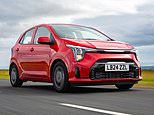 Kia's affordable Picanto offers a fun and nippy drive in the big city
Kia's affordable Picanto offers a fun and nippy drive in the big city -
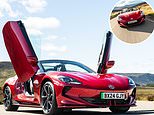 MG Cyberster review - convertible EV costs £60k and is fun to drive
MG Cyberster review - convertible EV costs £60k and is fun to drive -
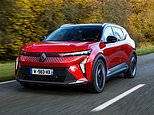 'Euros' winning Renault Scenic E-Tech gets Ray Massey's vote
'Euros' winning Renault Scenic E-Tech gets Ray Massey's vote -
 Ford Explorer: Is the £40k electric SUV a good buy for UK drivers?
Ford Explorer: Is the £40k electric SUV a good buy for UK drivers? -
 Polestar 3: Does the Tesla Model Y now have a real fight on its hands?
Polestar 3: Does the Tesla Model Y now have a real fight on its hands? -
 Lotus Eletre is an EV Lamborghini Urus rival: The hyper-SUV tested
Lotus Eletre is an EV Lamborghini Urus rival: The hyper-SUV tested -
 Dacia's new Duster is here - has it lost its value-for-money appeal?
Dacia's new Duster is here - has it lost its value-for-money appeal? -
 Alfa Romeo Tonale review: Can this SUV bring some sporting thrill?
Alfa Romeo Tonale review: Can this SUV bring some sporting thrill? -
 In a world of SUVs, can the VW Passat re-energise the estate market?
In a world of SUVs, can the VW Passat re-energise the estate market? -
 Ineos Quartermaster review: The new premium pick-up truck in town
Ineos Quartermaster review: The new premium pick-up truck in town -
 Peugeot e-3008 is attractive, sprightly and has a 326-mile range
Peugeot e-3008 is attractive, sprightly and has a 326-mile range -
 New £165k Aston Martin Vantage tested - is it better than a Ferrari?
New £165k Aston Martin Vantage tested - is it better than a Ferrari? -
 Can BMW harness the magic of the original Mini in an EV made in China?
Can BMW harness the magic of the original Mini in an EV made in China? -
 Is this the ultimate open-top super tourer? Aston Martin DB12 Volante
Is this the ultimate open-top super tourer? Aston Martin DB12 Volante -
 New Fiat 600e EV family car is here, but should wait for the hybrid?
New Fiat 600e EV family car is here, but should wait for the hybrid? -
 VW Tiguan review: Brand's best-selling SUV is back - but is it better?
VW Tiguan review: Brand's best-selling SUV is back - but is it better? -
 Should you consider the Mini Countryman EV instead of the petrol?
Should you consider the Mini Countryman EV instead of the petrol? -
 Another BMW goes electric - we test the new iX2 vs its petrol X2 rival
Another BMW goes electric - we test the new iX2 vs its petrol X2 rival -
 The 2024 Range Rover Evoque plug-in hybrid is a home-grown winner
The 2024 Range Rover Evoque plug-in hybrid is a home-grown winner -
 Britain's favourite car DRIVEN - we review the best-selling Ford Puma
Britain's favourite car DRIVEN - we review the best-selling Ford Puma -
 BMW's i5 EV offers supercar performance in an exec saloon package
BMW's i5 EV offers supercar performance in an exec saloon package -
 We drive the £76,000 Kia EV9 - Korea's all-electric Range Rover rival
We drive the £76,000 Kia EV9 - Korea's all-electric Range Rover rival -
 Has the BMW M3 Touring been worth the three-decade wait? Our review
Has the BMW M3 Touring been worth the three-decade wait? Our review -
 Has Britain's most popular small car just got much better? New Corsa
Has Britain's most popular small car just got much better? New Corsa -
 Volvo EX30 review: Sweden's new 'green' pocket rocket SUV rival Tesla
Volvo EX30 review: Sweden's new 'green' pocket rocket SUV rival Tesla -
 Is Renault's new Austral E-Tech SUV the complete package? We drive it
Is Renault's new Austral E-Tech SUV the complete package? We drive it -
 The Audi Q8 is annoyingly good for a 'sporty' coupe-style SUV
The Audi Q8 is annoyingly good for a 'sporty' coupe-style SUV -
 Ferrari Roma Spider costs £210k - here's what you get for your money
Ferrari Roma Spider costs £210k - here's what you get for your money -
 China's all-electric BYD Dolphin lands ashore - we test it on UK roads
China's all-electric BYD Dolphin lands ashore - we test it on UK roads -
 Our epic road test through Demark and Sweden in the new Polestar 2
Our epic road test through Demark and Sweden in the new Polestar 2 -
 New Abarth 500e convertible is a rare treat - it's electric and sporty
New Abarth 500e convertible is a rare treat - it's electric and sporty -
 Honda's new CR-V is bigger than its predecessor - but is it better?
Honda's new CR-V is bigger than its predecessor - but is it better? -
 We beat the new Bond to test his new car: Aston Martin DB12 review
We beat the new Bond to test his new car: Aston Martin DB12 review -
 Behind the wheel of Rolls-Royce's Spectre: We test the new EV Roller
Behind the wheel of Rolls-Royce's Spectre: We test the new EV Roller -
 Skoda's crowning glory: Superb L&K 4x4 Estate with extras driven
Skoda's crowning glory: Superb L&K 4x4 Estate with extras driven -
 Maserati Grecale test - the SUV with 50% of sales projected for women
Maserati Grecale test - the SUV with 50% of sales projected for women -
 Dacia's budget family car with seven seats! The £18,000 Jogger tested
Dacia's budget family car with seven seats! The £18,000 Jogger tested -
 This Q8 is just great: We take Audi's new Sportback e-tron for a spin
This Q8 is just great: We take Audi's new Sportback e-tron for a spin -
 Enter the Dragon! BYD Atto EV is the Chinese company's first UK model
Enter the Dragon! BYD Atto EV is the Chinese company's first UK model -
 Ferrari's first four-door family car: New £313,000 Purosangue driven
Ferrari's first four-door family car: New £313,000 Purosangue driven -
 Thrills without frills: £31,000 MG5 is one of the cheapest family EVs
Thrills without frills: £31,000 MG5 is one of the cheapest family EVs -
 Renault's Arkana ticks all the boxes for what car-buying Britons want
Renault's Arkana ticks all the boxes for what car-buying Britons want -
 Can Peugeot's chic 408 hybrid crossover be a hit in the UK? We test it
Can Peugeot's chic 408 hybrid crossover be a hit in the UK? We test it -
 We drive the Civic Type R - the rebellious bad boy in Honda's line-up
We drive the Civic Type R - the rebellious bad boy in Honda's line-up -
 Rolls Royce Spectre: What's it lke to drive the first ELECTRIC Roller?
Rolls Royce Spectre: What's it lke to drive the first ELECTRIC Roller? -
 Ineos Grenadier driven: Sir Jim Ratcliffe's £69,000 Defender
Ineos Grenadier driven: Sir Jim Ratcliffe's £69,000 Defender -
 Can you really live with a tiny Citroen Ami? Seven tasks in seven days
Can you really live with a tiny Citroen Ami? Seven tasks in seven days -
 Don't supersize me! Is the 'smaller' Volvo XC60 all the SUV you need?
Don't supersize me! Is the 'smaller' Volvo XC60 all the SUV you need? -
 We pamper some passengers in the new £211k Bentley Bentayga
We pamper some passengers in the new £211k Bentley Bentayga -
 New kind of Buzz! VW's electric MPV still feels like a hippy campervan
New kind of Buzz! VW's electric MPV still feels like a hippy campervan





